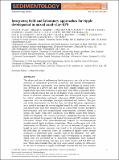Integrating field and laboratory approaches for ripple development in mixed sand–clay–EPS
Abstract
The shape and size of sedimentary bedforms play a key role in the reconstruction of sedimentary processes in modern and ancient environments. Recent laboratory experiments have shown that bedforms in mixed sand–clay develop at a slower rate and often have smaller heights and wavelengths than equivalent bedforms in pure sand. This effect is generally attributed to cohesive forces that can be of physical origin, caused by electrostatic forces of attraction between clay minerals, and of biological origin, caused by ‘sticky’ extracellular polymeric substances (EPS) produced by micro‐organisms, such as microalgae (microphytobenthos) and bacteria. The present study demonstrates, for the first time, that these laboratory experiments are a suitable analogue for current ripples formed by tidal currents on a natural mixed sand–mud–EPS intertidal flat in a macrotidal estuary. Integrated hydrodynamic and bed morphological measurements, collected during a spring tide under weak wave conditions near Hilbre Island (Dee Estuary, north‐west England, UK), reveal a statistically significant decrease in current ripple wavelength for progressively higher bed mud and EPS contents, and a concurrent change from three‐dimensional linguoid to two‐dimensional straight‐crested ripple planform morphology. These results agree well with observations in laboratory flumes, but the rate of decrease of ripple wavelength as mud content increased was found to be substantially greater for the field than the laboratory. Since the formation of ripples under natural conditions is inherently more complex than in the laboratory, four additional factors that might affect current ripple development in estuaries, but which were not accounted for in laboratory experiments, were explored. These were current forcing, clay type, pore water salinity and bed EPS content. These data illustrate that clay type alone cannot explain the difference in the rate of decrease in ripple wavelength, because the bed clay contents were too low for clay type to have had a measurable effect on bedform development. Accounting for the difference in current forcing between the field and experiments, and therefore the relative stage of development with respect to equilibrium ripples, increases the difference between the ripple wavelengths. The presence of strongly cohesive EPS in the current ripples on the natural intertidal flat might explain the majority of the difference in the rate of decrease in ripple wavelength between the field and the laboratory. The effect of pore water salinity on the rate of bedform development cannot be quantified at present, but salinity is postulated herein to have had a smaller influence on the ripple wavelength than bed EPS content. The common presence of clay and EPS in many aqueous sedimentary environments implies that a re‐assessment of the role of current ripples and their primary current lamination in predicting and reconstructing flow regimes is necessary, and that models that are valid for pure sand are an inappropriate descriptor for more complex mixed sediment. This study proposes that this re‐assessment is necessary at all bed clay contents above 3%.
Citation
Baas , J H , Baker , M L , Malarkey , J , Bass , S J , Manning , A J , Hope , J A , Peakall , J , Lichtman , I D , Ye , L , Davies , A G , Parsons , D R , Paterson , D M & Thorne , P D 2019 , ' Integrating field and laboratory approaches for ripple development in mixed sand–clay–EPS ' , Sedimentology , vol. 66 , no. 7 , pp. 2749-2768 . https://doi.org/10.1111/sed.12611
Publication
Sedimentology
Status
Peer reviewed
ISSN
0037-0746Type
Journal article
Description
This work was supported by the UK Natural Environment Research Council (NERC) under grant NE/I027223/1 (COHBED). DMP received funding from the Marine Alliance for Science and Technology for Scotland (MASTS), funded by the Scottish Funding Council (grant reference HR09011) and contributing institutions. AJM’s contribution to this manuscript was partly funded by HR Wallingford Company Research project ‘FineScale – Dynamics of Fine-grained Cohesive Sediments at Varying Spatial and Temporal Scales’ (DDY0523). JM and DRP were partially funded by a European Research Council Consolidator Award (725955).Collections
Items in the St Andrews Research Repository are protected by copyright, with all rights reserved, unless otherwise indicated.

